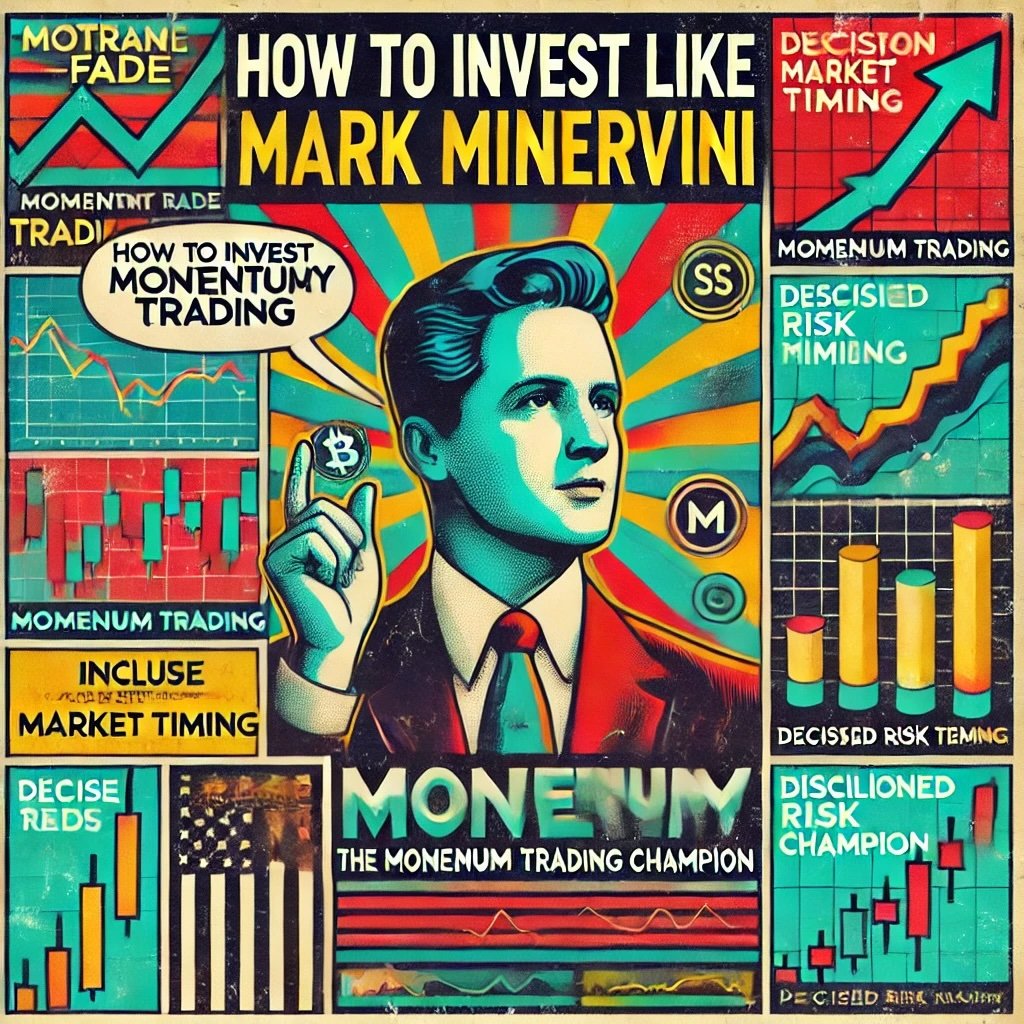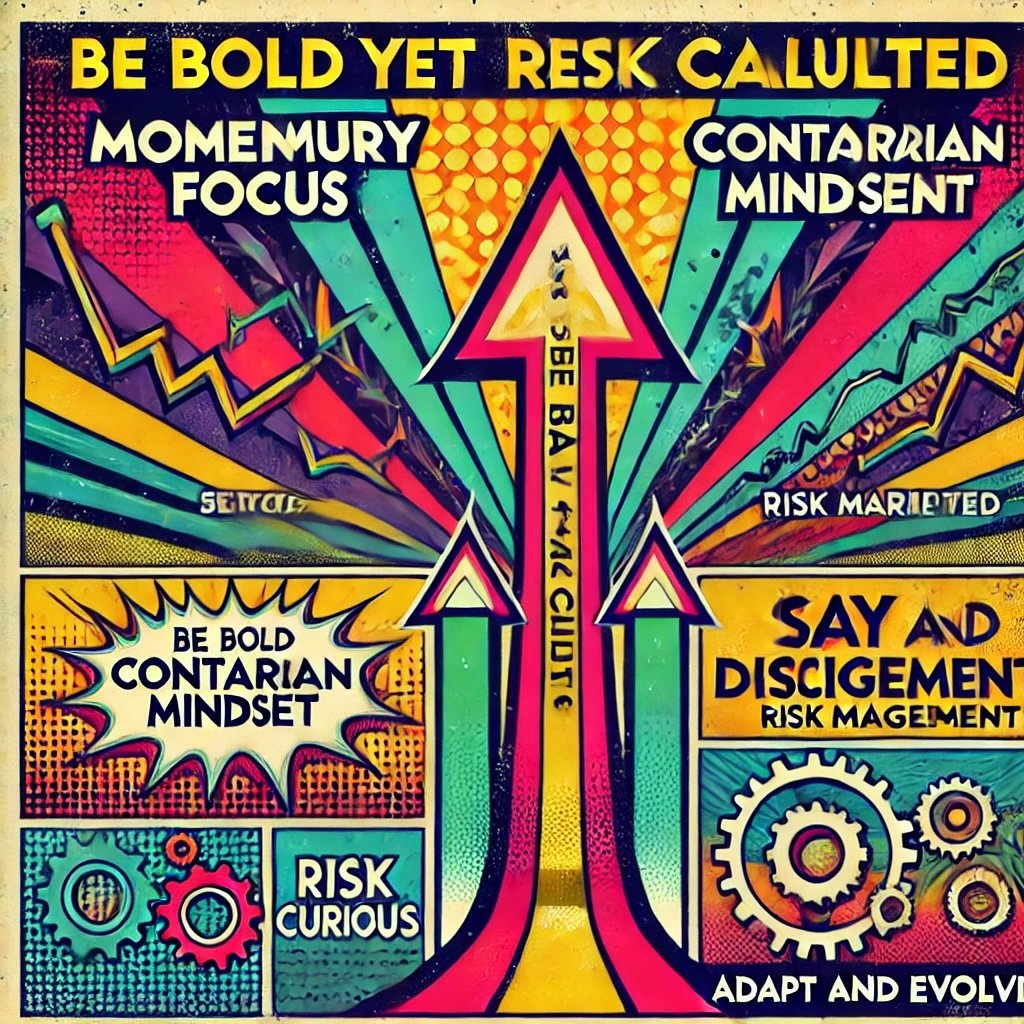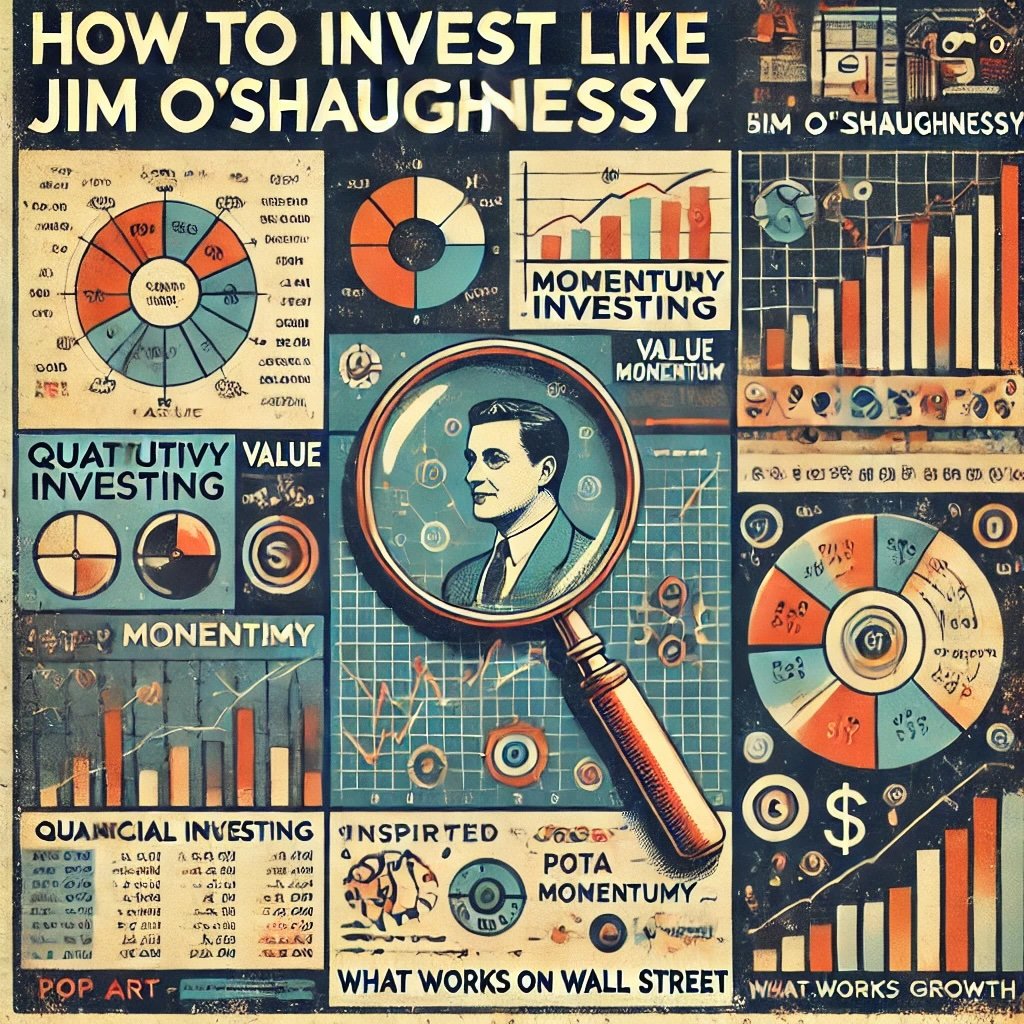Investing like a champion isn’t about luck; it’s about strategy, discipline, and a keen understanding of market dynamics. Mark Minervini, a renowned momentum trading champion, exemplifies these qualities through his proven trading strategies and disciplined approach. In this comprehensive guide, we’ll delve into Minervini’s journey, his momentum trading techniques, and how you can adopt his strategies to elevate your own trading game.
source: Financial Wisdom on YouTube
Mark Minervini: A Titan in Momentum Trading
Mark Minervini is a name that resonates deeply within the trading community. As a three-time U.S. Investing Champion, his track record speaks volumes about his expertise in momentum trading. Minervini’s approach isn’t just about picking winning stocks; it’s about understanding the underlying mechanics that drive market movements and capitalizing on them with precision.

The Significance of Momentum Trading
Momentum trading is a strategy that capitalizes on the continuance of existing trends in the market. Unlike value investing, which focuses on undervalued stocks, momentum trading seeks to ride the wave of stock price movements, both upward and downward. This strategy is particularly effective in volatile markets where stock prices can experience significant swings in short periods.
Let’s explore Mark Minervini’s trading strategies and his journey to becoming a momentum trading champion. Whether you’re a seasoned trader or a novice looking to enhance your trading skills, understanding Minervini’s approach can provide valuable insights and practical strategies to improve your trading performance.

Who is Mark Minervini?
Background and Early Life of Mark Minervini
Mark Minervini’s journey into the world of trading wasn’t paved with instant success. Born with a passion for numbers and a curiosity about financial markets, Minervini’s interest in trading began during his high school years. He pursued this interest with fervor, studying various trading strategies and market theories.
From Novice Trader to Momentum Trading Champion
Minervini’s transformation from a novice trader to a renowned momentum trading champion is a testament to his dedication and relentless pursuit of excellence. Early in his career, he faced numerous challenges, including significant financial losses. However, these setbacks only fueled his determination to master the art of trading.
His breakthrough came when he began to develop and refine his unique trading strategies, focusing on momentum and technical analysis. By combining these elements with disciplined risk management, Minervini consistently outperformed the market, leading him to victory in the prestigious U.S. Investing Championship.
Key Achievements
- U.S. Investing Championship Victory: Minervini clinched the top spot in the U.S. Investing Championship not once, but three times, showcasing his exceptional trading acumen.
- Authoring Influential Books: His book, “Trade Like a Stock Market Wizard,” has become a cornerstone resource for traders looking to adopt his strategies.
- Educational Endeavors: Through seminars, webinars, and mentorship programs, Minervini has educated countless traders, sharing his insights and strategies with a global audience.
- Public Speaking and Media Presence: Regularly featured in financial publications and media outlets, Minervini continues to influence the trading community with his expert commentary and analysis.

The Foundation of Momentum Trading
Understanding Momentum Trading
Momentum trading is predicated on the idea that stocks which have shown strong performance in the recent past will continue to do so in the near future. This strategy relies heavily on technical analysis, focusing on price movements, volume, and other market indicators to identify potential trading opportunities.
Core Principles of Momentum Trading
- Trend Identification: Recognizing and following the prevailing market trends.
- Volume Analysis: Assessing the trading volume to confirm the strength of a trend.
- Technical Indicators: Utilizing tools like moving averages, Relative Strength Index (RSI), and Bollinger Bands to gauge market momentum.
- Risk Management: Implementing strategies to protect against significant losses.
Mark Minervini’s Approach to Momentum Trading
Mark Minervini’s momentum trading strategy is not just about riding the wave; it’s about understanding the underlying forces that drive these movements. His approach integrates both technical and fundamental analysis, allowing him to make informed trading decisions based on comprehensive market insights.
Key Elements of Minervini’s Strategy:
- Technical Analysis: Focus on chart patterns, price movements, and volume to identify high-potential stocks.
- Fundamental Analysis: Assessing the company’s earnings, revenue growth, and other financial metrics to ensure the stock’s fundamental strength.
- Market Timing: Entering and exiting trades at optimal times to maximize returns and minimize losses.
- Discipline and Patience: Sticking to a well-defined trading plan and avoiding impulsive decisions based on emotions.

Core Principles of Mark Minervini’s Trading Strategy
Mark Minervini’s trading strategy is built upon several core principles that guide his decision-making process. These principles emphasize the importance of stock selection, risk management, market timing, and psychological discipline.
Stock Selection
Selecting the right stocks is the cornerstone of Minervini’s strategy. He employs a combination of technical and fundamental analysis to identify high-potential stocks that exhibit strong momentum.
Criteria for Choosing High-Potential Stocks:
- Strong Earnings Growth: Companies with robust and consistent earnings growth are more likely to sustain their upward momentum.
- Price and Volume: Stocks that show significant price appreciation accompanied by increasing volume are prime candidates.
- Relative Strength: Stocks that outperform the market or their sector peers tend to continue their upward trajectory.
- Chart Patterns: Identifying specific chart patterns such as cup-and-handle, flat bases, and flags that indicate potential for continued momentum.
Risk Management
Effective risk management is crucial to protect capital and ensure long-term success. Minervini places a strong emphasis on preserving capital through disciplined risk management techniques.
Key Risk Management Strategies:
- Capital Preservation: Prioritizing the protection of trading capital over maximizing returns.
- Position Sizing: Determining the appropriate size of each trade based on account size and risk tolerance.
- Stop-Loss Orders: Setting predetermined exit points to limit potential losses on each trade.
- Diversification: Spreading investments across various sectors and industries to mitigate risk.
Market Timing
Timing is everything in trading. Minervini believes that entering and exiting trades at the right time can significantly impact overall returns.
Strategies for Optimal Market Timing:
- Identifying Market Conditions: Assessing whether the market is in a bullish or bearish phase to align trading strategies accordingly.
- Technical Indicators: Using indicators like moving averages and RSI to determine optimal entry and exit points.
- Trend Confirmation: Ensuring that a trend is well-established before committing to a trade to increase the likelihood of success.
Discipline and Patience
Maintaining discipline and patience is essential for executing a successful trading strategy. Minervini advocates for a methodical approach, sticking to the trading plan and avoiding emotional decisions.
Principles of Discipline and Patience:
- Sticking to the Plan: Adhering strictly to predefined trading rules and strategies.
- Avoiding Impulses: Refraining from making trades based on emotions or market hype.
- Long-Term Focus: Concentrating on long-term gains rather than short-term fluctuations.
- Consistent Evaluation: Regularly reviewing and adjusting the trading strategy based on performance and changing market conditions.

The SEPA Strategy
One of the most distinctive aspects of Mark Minervini’s trading approach is his Specific Entry Point Analysis (SEPA) method. SEPA is a nuanced strategy that combines various technical indicators to pinpoint the most opportune moments for entering and exiting trades.
Overview of SEPA
Specific Entry Point Analysis (SEPA) is designed to identify precise entry points for high-potential trades. This method integrates chart patterns, volume analysis, and relative strength to ensure that trades are initiated only when multiple indicators align, signaling strong upward momentum.
Components of SEPA
- Chart Patterns: Identifying formations like cup-and-handle, flat bases, and flags that indicate potential for continued upward movement.
- Volume Analysis: Assessing trading volume to confirm the strength of a price movement. High volume accompanying price increases suggests strong buying interest.
- Relative Strength: Evaluating a stock’s performance relative to the broader market or its sector to ensure it is outperforming peers.
How SEPA Works
- Identification of Chart Patterns: Minervini scans for specific chart patterns that have historically led to significant price increases. For instance, a cup-and-handle pattern indicates a period of consolidation followed by a breakout.
- Volume Confirmation: Once a potential pattern is identified, the next step is to confirm it with volume analysis. A breakout accompanied by increasing volume signals strong buying interest, making it a favorable entry point.
- Relative Strength Assessment: Minervini ensures that the stock is demonstrating relative strength compared to the market. This involves comparing the stock’s performance to major indices or sector benchmarks.
- Optimal Entry Point: Combining these factors, SEPA identifies the optimal entry point where the probability of a successful trade is highest.
Examples of SEPA in Action
Example 1: Cup-and-Handle Pattern
- Chart Analysis: A stock forms a cup shape over a period of several weeks, followed by a handle formation.
- Volume Analysis: The breakout from the handle is accompanied by a spike in volume, confirming strong buying interest.
- Relative Strength: The stock outperforms its sector peers, indicating robust momentum.
- Action: Entering the trade at the breakout point with a stop-loss order below the handle to manage risk.
Example 2: Flat Base Formation
- Chart Analysis: A stock trades within a tight range, forming a flat base over several weeks.
- Volume Analysis: A breakout from the flat base is supported by increasing volume, suggesting a strong upward move.
- Relative Strength: The stock shows better performance relative to the market, indicating strong momentum.
- Action: Initiating the trade at the breakout point, with a trailing stop to capture gains as the stock continues to rise.
Effectiveness of SEPA
SEPA’s effectiveness lies in its ability to combine multiple indicators to ensure that trades are initiated only when several positive factors align. This method reduces the likelihood of false signals and increases the probability of successful trades. By adhering to SEPA, traders can enhance their precision in timing entries and exits, leading to improved trading performance.
Benefits of SEPA:
- Higher Success Rate: Combining multiple indicators increases the likelihood of successful trades.
- Reduced Risk: Precise entry and exit points help in managing risk effectively.
- Consistency: A systematic approach ensures consistent application of trading rules.

Famous Trades and Market Calls
Mark Minervini’s reputation as a momentum trading champion is built on a series of remarkable trades and accurate market calls. These successes highlight the effectiveness of his trading strategies and his ability to capitalize on market opportunities.
Turning Heads with Bold Predictions
One of Minervini’s most notable achievements was his victory in the U.S. Investing Championship, where his trading strategy outperformed thousands of other participants. His ability to make bold and accurate market calls during this competition underscored his expertise in momentum trading.
Global Macro Success Stories
Minervini’s momentum trading approach has led to several high-profile successes. These trades not only demonstrated his skill but also provided valuable lessons for traders aiming to emulate his success.
1. Apple Inc. (AAPL) Trade
Context: In early 2019, Apple Inc. was experiencing strong momentum, driven by robust earnings reports and positive market sentiment.
Trade Details:
- Entry Point: Minervini identified a cup-and-handle pattern on Apple’s chart, signaling a potential breakout.
- Volume Confirmation: The breakout was accompanied by increasing volume, confirming strong buying interest.
- Relative Strength: Apple outperformed its sector peers, indicating strong momentum.
Outcome: As anticipated, Apple’s stock surged, resulting in significant profits for Minervini’s portfolio. This trade exemplified his ability to identify high-potential stocks using SEPA and capitalize on their upward momentum.
2. Tesla Inc. (TSLA) Trade
Context: Tesla was on the cusp of a major breakthrough, with advancements in electric vehicle technology and expanding production capacities.
Trade Details:
- Chart Pattern: Minervini identified a flat base formation, indicating consolidation before a breakout.
- Volume Analysis: The subsequent breakout from the flat base was supported by a spike in trading volume.
- Relative Strength: Tesla exhibited strong relative strength, outperforming the broader market.
Outcome: Tesla’s stock experienced a dramatic rise, aligning with Minervini’s predictions. This trade showcased his ability to anticipate significant upward movements in high-potential stocks.
Lessons Learned from These Trades
Mark Minervini’s successful trades offer several key lessons for traders:
- Thorough Analysis: Combining technical and fundamental analysis to identify high-potential stocks.
- Discipline: Sticking to a well-defined trading plan and avoiding impulsive decisions.
- Risk Management: Implementing stop-loss orders and position sizing to manage risk effectively.
- Patience: Allowing trades the time to develop and realizing their full potential without premature exits.
Relevance of These Trades Today
The principles underlying Minervini’s successful trades remain highly relevant in today’s dynamic market environment. By adhering to his core strategies, traders can enhance their ability to identify and capitalize on momentum-driven opportunities.
Current Market Implications:
- Technological Advancements: Stocks in emerging technologies continue to offer high momentum opportunities.
- Market Volatility: In volatile markets, disciplined risk management and precise timing are crucial for success.
- Global Trends: Understanding global economic and technological trends can uncover lucrative trading opportunities.

Risk Management Techniques
Effective risk management is a cornerstone of Mark Minervini’s trading strategy. By implementing robust risk management techniques, Minervini ensures that potential losses are minimized while maintaining the potential for significant gains. This balance is essential for long-term trading success.
Diversification: The Cornerstone of Risk Management
Minervini emphasizes Diversification as a fundamental risk management strategy. By spreading investments across various asset classes and geographies, he mitigates the risks associated with market volatility and economic downturns in specific regions.
Key Diversification Strategies:
- Asset Classes: Investments are diversified across equities, bonds, commodities, and real estate to balance risk and reward.
- Geographical Spread: Exposure to both developed and emerging markets reduces the impact of localized economic issues.
- Sector Diversification: Investing in different sectors such as technology, healthcare, energy, and consumer goods to spread sector-specific risks.
Example: During periods of economic uncertainty in one region, investments in stable markets like the United States or diversified assets like gold can offset potential losses.
Balancing Risk and Reward
In volatile markets, balancing risk and reward is paramount. Minervini employs several strategies to ensure that potential losses are minimized while maintaining the potential for significant gains.
Strategies Employed:
- Hedging: Utilizing financial instruments such as options and futures to protect against adverse price movements.
- Asset Allocation: Strategically distributing investments based on risk tolerance, investment horizon, and market conditions.
- Position Sizing: Determining the appropriate size of each investment position to prevent excessive exposure to any single asset.
Example: When investing in emerging markets, Minervini might allocate a smaller percentage of the portfolio to high-risk assets while balancing it with more stable investments to maintain overall portfolio stability.
Adapting to Market Conditions
Flexibility is a key component of Minervini’s risk management approach. He continuously monitors global markets, adjusting his investment positions to align with changing economic conditions and emerging opportunities.
Implementation Tactics:
- Regular Reviews: Periodic assessment of the investment portfolio to ensure alignment with current market dynamics.
- Proactive Adjustments: Making timely changes to investment holdings in response to new information or shifts in market trends.
- Scenario Analysis: Evaluating different market scenarios to anticipate potential risks and prepare appropriate responses.
Example: During the 2008 financial crisis, Minervini adjusted the Quantum Fund’s positions by reducing exposure to highly volatile assets and increasing holdings in safer investments like government bonds and gold.
Additional Risk Management Best Practices
- Stop-Loss Orders: Implementing stop-loss orders to automatically sell assets when they reach a certain price, limiting potential losses.
- Risk-Reward Ratio: Assessing the potential return of an investment relative to its risk to ensure favorable risk-reward profiles.
- Continuous Learning: Staying informed about new risk management techniques and integrating them into the investment strategy.
- Stress Testing: Simulating various market conditions to understand potential impacts on the portfolio and develop contingency plans.
Example: Before entering a new investment, Minervini might conduct a stress test to evaluate how different economic scenarios could affect the asset’s performance, allowing him to make informed decisions about its suitability for the portfolio.
Case Study: Diversification During Commodity Price Fluctuations
Context: Commodity prices can be highly volatile, influenced by geopolitical events, natural disasters, and changes in global demand.
Minervini’s Approach:
- Diversifying Investments: Spreading investments across multiple commodities (e.g., oil, gold, agricultural products).
- Hedging: Using options to protect against significant price drops in key commodities.
- Balancing Exposure: Maintaining a balanced portfolio that includes both high-risk and low-risk assets.
Outcome: While some commodities may experience sharp declines, others may perform well, balancing the overall portfolio and reducing the impact of individual asset volatility.

The Role of Psychology in Trading
Mark Minervini acknowledges that Psychology plays a significant role in trading. Market sentiments, driven by fear and greed, often lead to irrational price movements. By understanding these psychological factors, traders can gain an edge in making informed decisions.
Understanding Market Psychology
Market psychology refers to the collective emotions and behaviors of investors that influence market movements. Minervini emphasizes the importance of recognizing these psychological factors to anticipate market trends.
Key Psychological Concepts:
- Herd Mentality: The tendency of investors to follow the majority, often leading to market bubbles or crashes.
- Fear and Greed: Emotional drivers that can cause overreactions in the market, leading to irrational investment decisions.
- Overconfidence: The belief in one’s ability to predict market movements accurately, potentially leading to excessive risk-taking.
Example: During periods of market euphoria, such as the dot-com bubble, herd mentality can drive asset prices to unsustainable levels. Recognizing this, Minervini may choose to reduce exposure to overvalued sectors to protect against potential downturns.
Maintaining Discipline and Emotional Control
One of Minervini’s key principles is maintaining Discipline and Emotional Control. In turbulent markets, it’s easy to succumb to fear or greed, leading to impulsive decisions that can harm the investment portfolio.
Strategies for Emotional Control:
- Sticking to the Strategy: Adhering to a well-defined investment plan regardless of short-term market fluctuations.
- Avoiding Emotional Decisions: Making rational decisions based on analysis rather than reacting to market hysteria.
- Mindfulness and Stress Management: Practicing mindfulness and stress-reduction techniques to maintain mental clarity and focus.
Example: During the 2008 financial crisis, while many investors panicked and sold off assets, Minervini remained calm and adhered to his investment strategy, allowing him to capitalize on the subsequent market recovery.
Patience and Conviction
Success in trading often requires Patience and Conviction. Minervini believes in holding investments long enough to see their true value, even when immediate returns are not apparent. This steadfastness can lead to substantial long-term gains.
Implementation Tactics:
- Long-Term Focus: Prioritizing long-term growth over short-term profits.
- Confidence in Analysis: Trusting in thorough research and analysis to guide investment decisions, even when facing skepticism from the market.
- Resisting Short-Term Temptations: Avoiding the urge to make frequent trades based on short-term market movements.
Example: Minervini’s long-term investment in agricultural commodities during the early 2000s required patience, as it took several years for global demand to significantly increase, ultimately leading to substantial profits.
Overcoming Psychological Biases
Investors must recognize and mitigate common psychological biases that can impair investment judgment.
Common Biases and Mitigation Strategies:
- Confirmation Bias: Seeking information that confirms existing beliefs. Mitigation: Actively seeking contradictory information to challenge assumptions.
- Anchoring: Relying too heavily on the first piece of information encountered. Mitigation: Evaluating all available data before making decisions.
- Loss Aversion: Preferring to avoid losses over acquiring gains. Mitigation: Focusing on the long-term potential of investments rather than short-term fluctuations.
Example: An investor may hold onto a losing stock due to loss aversion, hoping it will rebound. By recognizing this bias, Minervini would assess the fundamental value of the asset and decide whether to hold or sell based on objective analysis rather than emotional attachment.
Building Emotional Resilience
Developing emotional resilience is crucial for maintaining discipline and executing trading strategies effectively.
Strategies to Build Resilience:
- Continuous Education: Understanding market dynamics and investment principles to build confidence.
- Diversification: Reducing portfolio volatility through diversification, thereby lowering emotional stress.
- Support Systems: Engaging with mentors, financial advisors, and peer networks to gain perspective and support.
Example: By maintaining a diversified portfolio, an investor can reduce the emotional impact of a single asset’s poor performance, allowing them to stay focused on long-term goals rather than short-term losses.

Building a Momentum Trading Strategy
Inspired by Mark Minervini’s approach, developing a momentum trading strategy involves a systematic process of research, identification, diversification, monitoring, and continuous improvement. Here’s a step-by-step guide to crafting your own momentum trading strategy.
Step-by-Step Guide to Developing a Momentum Trading Strategy
- Research and Analysis
- Conduct Comprehensive Research: Start by conducting thorough research on global economic trends, political developments, and market dynamics.
- Utilize Quantitative and Qualitative Insights: Combine numerical data with qualitative assessments to form a holistic view of potential investments.
- Identify Opportunities
- Look for Growth Potential: Focus on sectors and regions with strong growth prospects, such as emerging markets or booming industries like technology and renewable energy.
- Assess Competitive Landscape: Evaluate the competitive environment to identify undervalued assets and companies with sustainable advantages.
- Diversify Investments
- Spread Across Asset Classes: Diversify your portfolio by investing in different asset classes, including stocks, bonds, commodities, and real estate.
- Geographical Diversification: Invest in both developed and emerging markets to mitigate regional risks.
- Monitor and Adjust
- Continuous Monitoring: Keep a close eye on your investments and the broader market environment.
- Be Prepared to Adjust: Modify your portfolio in response to changing economic conditions and emerging opportunities.
- Stay Informed
- Keep Up with Global News: Stay abreast of global news, economic reports, and market analyses that could impact your investments.
- Leverage Multiple Information Sources: Utilize a variety of information sources, including financial news outlets, research reports, and expert opinions.
Identifying and Analyzing Potential Investment Opportunities
Minervini’s approach involves a meticulous process to identify undervalued assets and growth opportunities. This process ensures that trades are initiated based on solid analysis rather than speculation.
- Economic Indicators: Analyze GDP growth rates, inflation, and employment data to assess economic health.
- Political Stability: Evaluate the political environment to gauge the risk of policy changes or instability.
- Industry Trends: Identify industries poised for growth based on technological advancements or shifting consumer preferences.
- Local Insights: Understand cultural and regulatory factors that can influence market performance in specific regions.
Tools and Techniques:
- Fundamental Analysis: Assess the intrinsic value of an investment by examining related economic, financial, and other qualitative and quantitative factors.
- Technical Analysis: Use statistical trends gathered from trading activity, such as price movement and volume, to identify potential investment opportunities.
- Sentiment Analysis: Gauge investor sentiment through surveys, news sentiment, and market indicators to predict potential market movements.
Tips for Refining and Adapting the Strategy Over Time
- Stay Flexible: Be ready to pivot your strategy as new information and trends emerge. Flexibility allows you to capitalize on unexpected opportunities and mitigate emerging risks.
- Learn Continuously: Invest in your education to stay ahead of market developments. Attend seminars, read extensively, and engage with financial experts to enhance your knowledge.
- Seek Expertise: Collaborate with analysts and industry experts to gain diverse perspectives. Leveraging specialized knowledge can provide deeper insights into complex markets.
Additional Tips:
- Regular Portfolio Reviews: Conduct periodic reviews of your portfolio to assess performance and make necessary adjustments.
- Set Clear Goals: Define your investment objectives and align your strategy to achieve them.
- Maintain Discipline: Stick to your investment plan and avoid making impulsive decisions based on short-term market movements.
Implementing the Strategy: A Practical Example
Example: Investing in Renewable Energy Markets
- Research and Analysis
- Global Trends: Identify the increasing global focus on renewable energy sources to combat climate change.
- Economic Indicators: Assess the growth rates of renewable energy sectors in various countries.
- Identify Opportunities
- Growth Regions: Focus on countries like Germany, China, and the United States, where renewable energy investments are booming.
- Innovative Companies: Identify companies leading in solar, wind, and battery technologies.
- Diversify Investments
- Asset Classes: Invest in renewable energy stocks, green bonds, and commodities like lithium for batteries.
- Geographical Spread: Allocate investments across different regions to mitigate regional regulatory risks.
- Monitor and Adjust
- Track Developments: Stay updated on policy changes, technological advancements, and market demand shifts.
- Rebalance Portfolio: Adjust holdings based on performance and emerging opportunities within the renewable sector.
- Stay Informed
- Industry Reports: Regularly review reports from energy research firms.
- Expert Opinions: Attend industry conferences and webinars to gain insights from thought leaders.
Outcome: By following this strategy, an investor can effectively capitalize on the growing renewable energy sector, achieving both financial returns and contributing to sustainable development.

Challenges of Momentum Trading
While momentum trading offers significant opportunities, it also comes with its own set of challenges. Understanding these challenges and implementing strategies to overcome them is crucial for success.
Potential Pitfalls in Momentum Trading
- Market Volatility: Sudden economic or political changes can lead to unpredictable market movements, impacting investment returns.
- Complexity: Understanding and analyzing global markets requires extensive knowledge and resources, making it a complex endeavor.
- Currency Risks: Fluctuations in currency exchange rates can affect the value of international investments, introducing additional risk.
- Geopolitical Risks: Political instability, regulatory changes, and international conflicts can have significant impacts on global markets.
- Liquidity Issues: Some emerging markets and niche sectors may have lower liquidity, making it challenging to enter or exit positions without affecting prices.
Overcoming Common Challenges in Momentum Trading
To navigate these challenges effectively, investors should adopt the following strategies:
- Diversify: Spread investments across various markets and asset classes to minimize the impact of any single market downturn.
- Stay Informed: Maintain a continuous flow of information about global events and trends to anticipate and react to changes promptly.
- Use Hedging Strategies: Implement financial instruments like options and futures to protect against adverse currency movements and market volatility.
- Engage Local Expertise: Collaborate with local experts and analysts to gain deeper insights into regional markets and regulatory environments.
- Maintain Liquidity: Ensure a portion of the portfolio remains liquid to capitalize on emerging opportunities and manage unforeseen risks.
Example: An investor diversified their portfolio across North America, Europe, Asia, and emerging markets, reducing the impact of economic downturns in any single region. Additionally, by using currency hedging, they protected against significant exchange rate fluctuations that could erode investment returns.
The Importance of Staying Informed and Adaptable
In the ever-evolving global landscape, staying informed and adaptable is crucial. Investors must continuously update their knowledge and be willing to adjust their strategies to align with new developments and emerging opportunities.
Key Practices:
- Regular Learning: Commit to ongoing education about global markets, economic theories, and investment strategies.
- Adaptability: Be prepared to modify your investment approach in response to shifting market conditions and new information.
- Proactive Decision-Making: Anticipate changes and act proactively rather than reactively to maintain a competitive edge.
- Technology Utilization: Leverage advanced analytical tools and platforms to monitor global markets in real-time and make informed decisions.
Example: As renewable energy became a significant trend, an adaptable investor shifted a portion of their portfolio from traditional energy sectors to renewable technologies, positioning themselves to benefit from the growing demand for sustainable energy solutions.
Additional Challenges and Mitigation Strategies
- Regulatory Compliance: Navigating different regulatory environments requires understanding and compliance with local laws.
- Mitigation: Stay updated on regulatory changes and consult with legal experts when necessary.
- Cultural Differences: Cultural nuances can impact business operations and market behavior.
- Mitigation: Develop cultural awareness and incorporate it into investment analysis.
- Information Overload: The vast amount of data available can be overwhelming.
- Mitigation: Focus on key indicators and utilize data analytics tools to filter relevant information.
- Time Zone Differences: Operating across multiple time zones can complicate market monitoring and decision-making.
- Mitigation: Utilize technology and establish a team that can provide around-the-clock coverage of key markets.
Case Study: Navigating Geopolitical Tensions
Context: During heightened geopolitical tensions between the U.S. and China, markets became volatile, with significant impacts on trade, technology, and global supply chains.
Minervini’s Approach:
- Analysis: Assessed the long-term implications of the tensions on various sectors, particularly technology and manufacturing.
- Diversification: Reduced exposure to sectors most affected by the tensions while increasing investments in resilient industries like healthcare and consumer staples.
- Hedging: Utilized options to protect against potential downturns in highly volatile sectors.
Outcome: By proactively adjusting his portfolio, Minervini mitigated potential losses and positioned the fund to benefit from sectors that thrived despite geopolitical challenges.

How to Start Trading Like Mark Minervini
Adopting Mark Minervini’s trading strategies involves more than just understanding his techniques; it requires a disciplined approach, continuous learning, and the right tools and resources. Here’s a practical guide to implementing Minervini’s strategies in your own trading.
Practical Steps for Implementing Minervini’s Strategies
- Develop a Global Perspective
- Travel and Explore: Gain firsthand insights into different markets by traveling and exploring various countries.
- Engage with Local Experts: Collaborate with local analysts and industry experts to understand regional market dynamics.
- Implement a Robust Research Process
- Combine Technical and Fundamental Analysis: Use both technical charts and fundamental financial metrics to identify high-potential stocks.
- Leverage Advanced Analytical Tools: Utilize software and platforms that provide comprehensive market data and analysis tools.
- Adopt a Disciplined Investment Strategy
- Define Clear Trading Rules: Establish a set of rules that govern when to enter and exit trades, based on your analysis.
- Stick to the Plan: Maintain discipline by adhering strictly to your trading rules, even during market volatility.
- Focus on Continuous Learning
- Stay Updated: Keep abreast of the latest market trends, economic developments, and trading strategies.
- Attend Seminars and Webinars: Participate in educational events to enhance your knowledge and skills.
- Read Extensively: Consume books, research papers, and articles on trading and market analysis.
- Cultivate Emotional Resilience
- Practice Mindfulness: Engage in mindfulness and meditation to improve focus and reduce stress.
- Build a Support Network: Connect with mentors, peers, and financial advisors who can provide guidance and support.
- Maintain a Balanced Lifestyle: Ensure that you maintain a healthy work-life balance to sustain long-term trading performance.
- Leverage Technology and Data Analytics
- Use Trading Platforms: Choose trading platforms that offer advanced charting tools, real-time data, and efficient order execution.
- Implement Automated Tools: Utilize automated trading tools and algorithms to execute trades based on predefined criteria.
- Analyze Big Data: Incorporate big data analytics to gain deeper insights into market trends and patterns.
- Engage in Ethical Investing
- Uphold High Ethical Standards: Ensure that your trading practices are ethical and compliant with regulatory standards.
- Consider Social and Environmental Impacts: Evaluate the social and environmental impact of your investments to contribute to sustainable development.
Resources for Learning More About Momentum Trading Techniques
- Books
- “Trade Like a Stock Market Wizard” by Mark Minervini: An in-depth guide to his trading strategies and techniques.
- “Think and Trade Like a Champion” by Mark Minervini: Expands on the psychological aspects of trading and risk management.
- Online Courses and Seminars
- Minervini Private Access (MPA): A subscription-based platform offering exclusive trading insights and education.
- Webinars and Workshops: Regularly attend Minervini’s webinars and workshops to stay updated with his latest strategies and market outlooks.
- Financial News Outlets
- Bloomberg, CNBC, Reuters: Follow these outlets for real-time market news and analysis.
- TradingView: Utilize platforms like TradingView for advanced charting and market analysis tools.
- Trading Communities and Forums
- Elite Trader, Trade2Win: Engage with other traders to exchange ideas and insights.
- Reddit (r/stocks, r/Daytrading): Participate in discussions and gain diverse perspectives on trading strategies.
Tools and Platforms to Support Momentum Trading Activities
- Charting Software
- TradingView: Offers comprehensive charting tools, customizable indicators, and social trading features.
- MetaTrader 4/5: Popular platforms among traders for executing trades and utilizing automated trading systems.
- Stock Screeners
- Finviz: A powerful stock screener that allows for advanced filtering based on technical and fundamental criteria.
- Stock Rover: Provides detailed stock analysis and screening capabilities.
- Automated Trading Tools
- Trade Ideas: An AI-powered trading assistant that identifies trading opportunities based on your criteria.
- QuantConnect: A platform for developing and backtesting algorithmic trading strategies.
- Portfolio Management Software
- Personal Capital: Offers tools for tracking and managing your investment portfolio.
- Morningstar: Provides comprehensive data and analysis on various investment portfolios.
Practical Steps to Get Started
- Set Up a Trading Account
- Choose a reputable brokerage that offers the tools and resources you need for momentum trading.
- Ensure the platform provides access to real-time data, advanced charting tools, and efficient order execution.
- Develop Your Trading Plan
- Define your investment goals, risk tolerance, and trading style.
- Outline your criteria for stock selection, entry and exit points, and risk management strategies.
- Start Small
- Begin with a smaller investment to test your strategy and gain practical experience.
- Gradually increase your investment as you become more comfortable and confident in your approach.
- Track and Analyze Your Trades
- Keep a detailed journal of your trades, including entry and exit points, reasons for the trade, and outcomes.
- Regularly review your performance to identify strengths and areas for improvement.
- Stay Disciplined
- Adhere strictly to your trading plan and avoid making impulsive decisions based on emotions or market hype.
- Continually refine your strategy based on your trading experiences and market changes.

How To Invest Like Mark Minervini — 12-Question FAQ
What makes Mark Minervini’s approach different from other momentum traders?
Minervini blends powerful price/volume tactics with strict risk control and selective fundamentals (fast revenue/earnings growth, strong margins, leadership within an industry). His playbook centers on low-risk entries near proper pivots, selling quickly if wrong, and pressing winners only when the trend confirms.
What is the essence of Minervini-style momentum?
Buy high-quality leaders breaking out of sound bases as they transition from consolidation to institutional accumulation. Momentum is confirmed through tight price action, expanding volume on breakouts, relative strength leadership, and broad market alignment.
What is SEPA (Specific Entry Point Analysis)?
SEPA is Minervini’s method to synchronize entry with the moment of least risk. It combines:
a constructive base (e.g., cup-with-handle, flat base, shelf),
tight price contractions into the pivot,
volume dry-up before the move and expansion on breakout, and
relative strength already outperforming.
The goal is to enter as the stock proves itself, not before.
How does the VCP (Volatility Contraction Pattern) fit in?
VCP is a hallmark setup: a series of successively smaller pullbacks that tighten volatility and shake out weak holders. When price contracts, dries up in volume, and then thrusts through a well-defined pivot, odds improve that a sustained trend is starting.
Which fundamentals matter most in his screens?
He favors top-line and bottom-line acceleration, high return on capital, strong margins, category leadership, and clear catalysts (new product, pricing power, market share gains). Fundamentals validate the technical story and help avoid low-quality momentum.
How do I time breakouts the Minervini way?
Wait for decisive price through the pivot with above-average volume and no immediate rejection. Avoid extended entries; he prefers buying close to the pivot where risk is smallest and stops can be tight under nearby logical levels.
What risk management rules are central to his method?
Small, predefined losses (tight stops just below structural levels).
Position sizing based on distance to stop (risk per trade fixed).
Quick sell if the breakout fails; hold and pyramid only if price behaves well.
Never average down. Risk control is non-negotiable.
How does he handle selling and trade management?
Three buckets:
Sell fast if the breakout fails.
Trim or exit on abnormal action (high-volume stalling, decisive break of key moving averages).
Let leaders run while raising stops beneath higher lows/short MAs to protect gains.
How important is the overall market trend?
Critical. He aligns new buys with constructive market conditions (breadth, leading indexes, risk-on tone). In corrective phases, exposure is cut, and new buys are rare. Market context often explains why good setups work—or don’t.
What common mistakes do traders make trying to copy Minervini?
Chasing extended breakouts far above pivots.
Loose stops that turn small errors into big losses.
Buying laggards instead of true leaders.
Ignoring volume clues (no dry-up pre-breakout, no thrust on breakout).
Fighting the market instead of aligning with it.
Can I apply this approach to small accounts?
Yes. Tight-risk entries and position sizing by risk (not by round lots) make it scalable. Focus on A-setups only, keep commissions/slippage low, and log every trade to refine execution.
What’s a simple starter checklist?
Leadership: Top RS in its group; fundamentals supportive.
Base quality: Tight, orderly, rising lows; clear pivot.
VCP traits: Contractions getting smaller; volume dry-up near the right side.
Breakout day: Strong close through pivot on expanding volume.
Risk plan: Stop just below structure; size so 1R loss is acceptable.
Market: Trend and breadth supportive.
Key Takeaways from Mark Minervini’s Trading Approach
Mark Minervini’s trading philosophy is a harmonious blend of strategic foresight, disciplined execution, and a profound understanding of market dynamics. His emphasis on momentum trading, contrarian strategies, risk management, and psychological discipline offers invaluable lessons for traders aiming to navigate the complexities of the financial markets.
Core Takeaways:
- Momentum Focus: Identifying and capitalizing on stocks with strong upward momentum.
- Contrarian Mindset: Taking positions opposite to prevailing market sentiments to uncover undervalued opportunities.
- Risk Management: Implementing robust risk management techniques to protect capital and ensure long-term success.
- Psychological Discipline: Maintaining emotional control and sticking to a well-defined trading plan.
Relevance of Momentum Trading in Today’s Markets
In today’s fast-paced and interconnected global economy, the principles of momentum trading remain highly relevant. With the advent of advanced technology and real-time data, traders have unprecedented access to market information, enabling them to make informed and timely investment decisions. Momentum trading, with its focus on capturing market trends and maximizing returns, aligns perfectly with the dynamic nature of modern markets.
Current Market Implications:
- Technological Advancements: The rise of algorithmic trading and AI-driven analysis has amplified the effectiveness of momentum strategies.
- Globalization: Increased interconnectivity between markets means that momentum can build rapidly across different regions and sectors.
- Economic Shifts: Emerging markets continue to offer high growth potential, providing fertile ground for momentum traders.
Explore and Experiment with These Strategies
Adopting Mark Minervini’s trading strategies requires courage, commitment, and a willingness to explore uncharted territories. However, by embracing his principles and continuously refining your approach, you can enhance your trading outcomes and build a robust portfolio poised for long-term success.
Final Encouragement:
- Be Bold Yet Calculated: Take decisive actions based on thorough research and analysis.
- Stay Curious: Continuously seek knowledge and explore new markets and sectors.
- Adapt and Evolve: Be willing to change your strategies in response to new information and market conditions.
- Maintain Integrity: Uphold ethical standards in all investment decisions to build trust and ensure long-term success.
- Embrace Patience: Allow your investments the time to grow and realize their full potential.
Final Thought: Investing like Mark Minervini isn’t about replicating his every move but about understanding and embracing the underlying principles that have driven his success. It’s about combining technical expertise with disciplined risk management and psychological resilience to navigate the ever-changing landscape of the financial markets.
Important Information
Comprehensive Investment Disclaimer:
All content provided on this website (including but not limited to portfolio ideas, fund analyses, investment strategies, commentary on market conditions, and discussions regarding leverage) is strictly for educational, informational, and illustrative purposes only. The information does not constitute financial, investment, tax, accounting, or legal advice. Opinions, strategies, and ideas presented herein represent personal perspectives, are based on independent research and publicly available information, and do not necessarily reflect the views or official positions of any third-party organizations, institutions, or affiliates.
Investing in financial markets inherently carries substantial risks, including but not limited to market volatility, economic uncertainties, geopolitical developments, and liquidity risks. You must be fully aware that there is always the potential for partial or total loss of your principal investment. Additionally, the use of leverage or leveraged financial products significantly increases risk exposure by amplifying both potential gains and potential losses, and thus is not appropriate or advisable for all investors. Using leverage may result in losing more than your initial invested capital, incurring margin calls, experiencing substantial interest costs, or suffering severe financial distress.
Past performance indicators, including historical data, backtesting results, and hypothetical scenarios, should never be viewed as guarantees or reliable predictions of future performance. Any examples provided are purely hypothetical and intended only for illustration purposes. Performance benchmarks, such as market indexes mentioned on this site, are theoretical and are not directly investable. While diligent efforts are made to provide accurate and current information, “Picture Perfect Portfolios” does not warrant, represent, or guarantee the accuracy, completeness, or timeliness of any information provided. Errors, inaccuracies, or outdated information may exist.
Users of this website are strongly encouraged to independently verify all information, conduct comprehensive research and due diligence, and engage with qualified financial, investment, tax, or legal professionals before making any investment or financial decisions. The responsibility for making informed investment decisions rests entirely with the individual. “Picture Perfect Portfolios” explicitly disclaims all liability for any direct, indirect, incidental, special, consequential, or other losses or damages incurred, financial or otherwise, arising out of reliance upon, or use of, any content or information presented on this website.
By accessing, reading, and utilizing the content on this website, you expressly acknowledge, understand, accept, and agree to abide by these terms and conditions. Please consult the full and detailed disclaimer available elsewhere on this website for further clarification and additional important disclosures. Read the complete disclaimer here.





want to learn from you